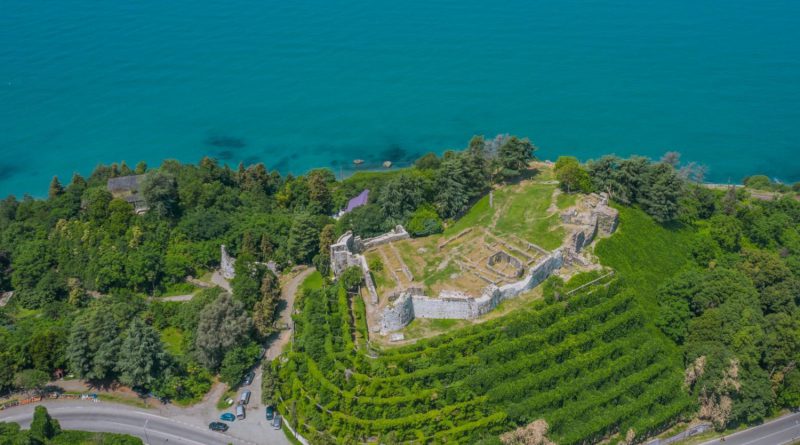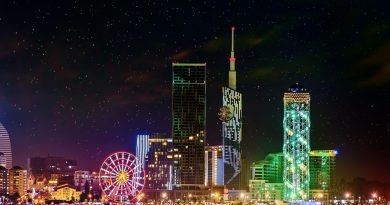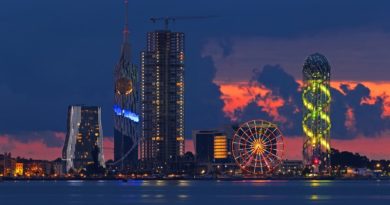Discover Adjara – fortresses
Adjara, one of the most beautiful corners of Georgia, is distinguished not only by its extraordinary nature, beautiful Black Sea coasts and sunny days, but also by special and important cultural heritage monuments, Starting with the unique Gonio Fortress dating back to the first century, which connects one of these ancient parts of Georgia with the ancient and Byzantine eras, and ending with the Petra Fortress, located a few tens of kilometers away, which connected the Byzantine provinces of western Georgia with Iran and Armenia.
Petra Fortress
A historic fortress-town in Adjara, Kobuleti municipality, on the territory of the village Tsikhisdziri. The Fortress was built by John Strategos in 535. Researchers suggest that the goblin fortress mentioned many times in Shota Rustaveli’s ” The Knight in the Panther’s Skin” is the fortress of Petra. At the edge of the sea, on a rocky hill, was the Acropolis of Petra, which was considered an inaccessible fortress. Hence its Greek name “Petra” – stone, rock. Here are the ruins of a Fortress, palace and soldiers’ quarters, including the foundations of the VI-VII centuries basilica, the remains of the Episcopal Cathedral of Petra, and other interesting artifacts.
The adventures of this fortress town have been the subject of discussion among historians since the 1930s (when it was referred to by the Swiss archaeologist Frederic Dubois de Montpéreux). Several reconnaissance excavations were carried out here first in 1934 by S. Janashia, and the other in 1953 led by N. Khoshtaria. A rich tomb was discovered here in 1908 (a large crystal encased in a gold frame was found here and is kept at the Hermitage.). According to N. Khoshtaria, the excavation of the treasure discovered during the excavations revealed that in the first centuries of the A.D., Petra Fortress was the residence of Eristavi.
Archaeological work on the fortress has been going on since 1987. Petra fortress Museum-Reserve has been operating since 1989. The museum preserves material found during archeological excavations in the area of the complex, which covers the period from the Bronze Age to the early Middle Ages:
- Architectural details,
- Fragments of mosaics,
- Materials of VIII-VI centuries stands,
- Remains of altars and buildings of IV-V centuries,
- Ceramics,
- Numismatic materials and more.
The ruins of the fortress, which witnessed many battles, can be seen from the sea and will make the visitor think about the stories of the mossy past.
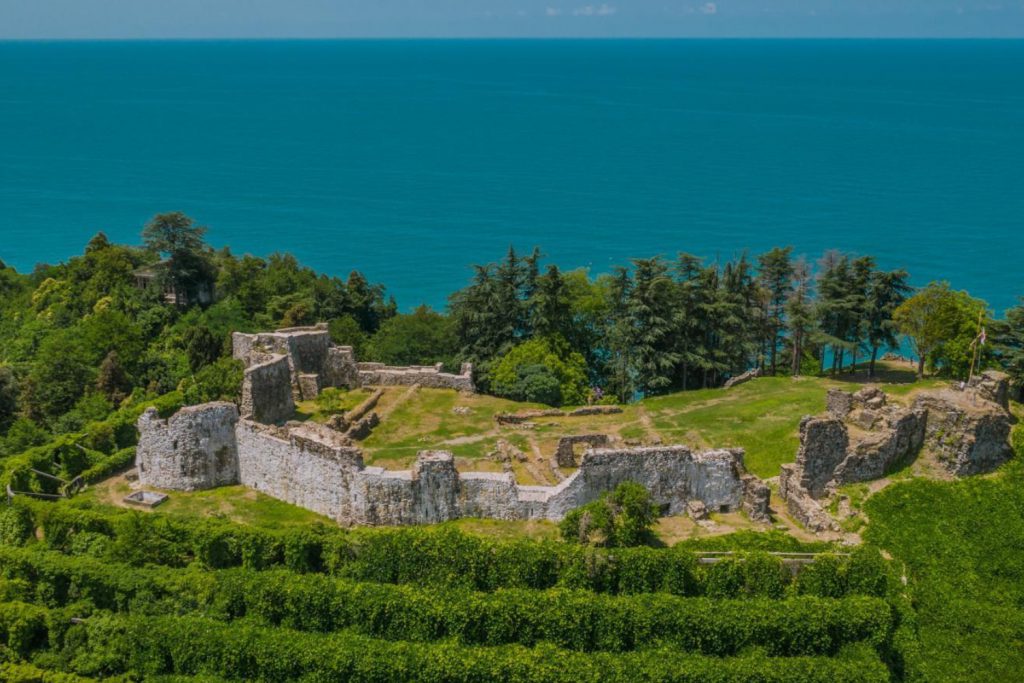
Gonio Fortress
In the distance of 12 km south from Batumi, on the left bank of the river Chorokhi, is the 1st century fortress of Gonio-Apsaros. One of the oldest settlements in Georgia was built around this fortress. Gonio-Apsaros Fortress had a unique strategic importance. It protected the entrances to the Chorokhi and Adjaristskali gorges, which connected southwestern Georgia and the regions with the Black Sea coast. Due to this location, Gonio Fortress became one of the citadels of the Roman Empire, then Byzantium and the Ottoman Empire on the eastern Black Sea coast. Accordingly, the fortress includes several layers: Roman (III-IV centuries BC), Byzantine (VI-VII centuries) and Ottoman (XVI century). Along with all this, Gonio Fortress was one of the strategic defense points of the Georgian kings, which was irreplaceable in the fight with the enemies.
Gonio Fortress has a museum-reserve since 2010, where exhibits dating back to the 80s of the XIX century BC are kept.
The history of Gonio-Apsaros is closely connected with the myth of the Argonauts. It is known that it was here that King Aeetes buried his son Apsaros, who was killed by the fleeing Argonauts. According to legend, Matata, one of the 12 apostles of Christ, is buried here.

Khikhani Fortress
Khikhani Fortress is located at the Skhalta-Khikhani headwaters, 125 km away from Batumi, on one of the branches of Arsiani Mountain, on the Adjara-Shavsheti border, at 2235 meters above sea level.
The fortress includes various buildings: a ringwall, towers, a church and the remains of various buildings.
Khikhani Fortress is one of the most important fortresses in Adjara. It was built on a very important strategic place and was one of the shelters of Georgian nobles. When the enemy defeated the fortresses of Tbilisi and Gori, they took refuge in this fortress.
There are several layers in the construction of the fortress: the oldest – X-XI centuries, the new XVII-XIX centuries (during the Ottoman rule). The area of the fortress is several hectares, only a small part of which is occupied, and most of it is sloping and steep. Ruins of many buildings have been found in Khirkhati, some of them are partially preserved, and some are completely leveled to the ground.
There are several layers in the construction of the fortress: the oldest – X-XI centuries, the new XVII-XIX centuries (during the Ottoman rule).
The area of the fortress is several hectares, only a small part of which is occupied, and most of it is sloping and steep. Ruins of many buildings have been found in Khirkhati, some of them are partially preserved, and some are completely leveled to the ground.
- Currently, the remains of four towers are preserved in Khirkhati.
- There are five pitchers proven to be dug in the ground in front of this tower (some are whole and some are damaged), Khikhani Cellar: The cellar, as it is known, used to be located in a special building – a wine house. Such a “wine house” should be the building, the remains of which are preserved here. It is a rectangular building with a length of 12 meters and a width of 4.5 meters. Its north wall is leveled to the ground, while the south wall is preserved up to one meter high.
- The fortress had a ringwall. Brick is also used in its arrangement. The height of the surviving walls reaches 5-6 m. Thickness is 90-95 cm. The walls of the ringwall are fitted to the outer inaccessible edges of the rock, so its plan also largely follows the terrain.
Currently, the walls are damaged and broken in many places
In 2014, the cellar of the Fortress was also excavated. A total of 28 pitchers were found. The south-eastern part of the rectangular cellar is tumbled in the cliff. It should have had an entrance from the same side. The walls are preserved at a height of 1.5-2 m, thickness is 60-70 cm. The cellar was a semi-underground building. In 2015, 43 pitchers were found in the second cellar.
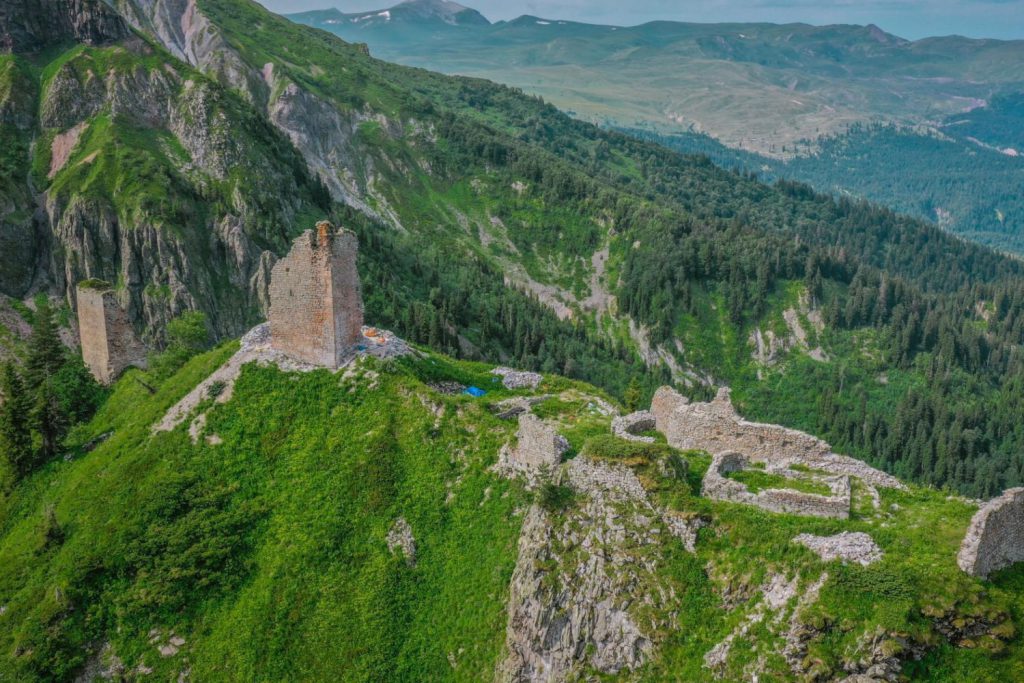
Kaviani Fortress
Kaviani Fortress – a fortification building in Keda Municipality. It is located on Kaviani Hill on the left side of the confluence of the rivers Chvanistskali and Adjaristskali. Its height is 550 meters above sea level. The Fortress overlooks the main highway of River Adjaristskali gorge.
The Fotress consists of two sections. The first section, according to the fossils that have come down to us, may have been a storage room of some purpose, which was supposed to have been three storeys high. There are two foundations and two windows on the wall. In this tower of the fortress there is a straight shaped pit, which is lined with lime.
In the second section of the fortress, which covers an area of 112 square meters, there is a well-preserved north tower, which is in the shape of an irregular rectangle and also consisted of three floors. There are windows in the tower. The western wall of the Fortress yard, which is 7.1 meters long and 5 meters high, is relatively well preserved. The fortress is built of flat stones, internal cobblestones can also be found occasionally.
Zendidi Fortress
Zendidi Fortress is located on a high hill in the village of the same name in Keda Municipality. About 42 kilometers from Batumi, and 2 kilometers from the center of Keda.
In the VII-IX centuries, the main vessel of the Batumi-Artanuji trade and economic union passed through Keda, as Vakhushti Bagrationi says, The lord of Adjara lived in a “small city-like town of Keda.”
Therefore, Keda needed proper defense. This defense was presented in the form of Zendidi Fortress. In Adjara gorge, along with other fortifications, namely Begoshvilis, Tsivasula, Sagoreti, Mtis Ubani, Chkhutuneti, other fortresses were responsible not only for the protection of the ridge but also for the central strategic trade routes leading to the gorge.
The date of construction of the fortress is unknown to us, but nevertheless the architectural details point to early century. The fortress has survived to our time in a very damaged, almost ruined form.
Tsivasula fortress
A late medieval fortress located at the confluence of the Agarisghele and Adjaristskali rivers, above a place called Tsivasula, in the eastern part of Sasire Hill. The fortress is of strategic importance. Access is only from the north-west, in the form of a narrow path.
It dates back to the XI-XIII centuries. The fortress was of strategic importance, its main function was to control the roads leading to Adjaristskali gorge and Agaristskali.
Built on a high, rocky cape, it is almost inaccessible, it has access only from the north-west, in the form of a narrow path. The fortress is small and quite damaged, its area is about 400 m. The contour of the fortress built of flat stone follows the contour of the rock in a curved line. The north and south walls of the fortress and partly the upper part of the east wall are preserved today.

